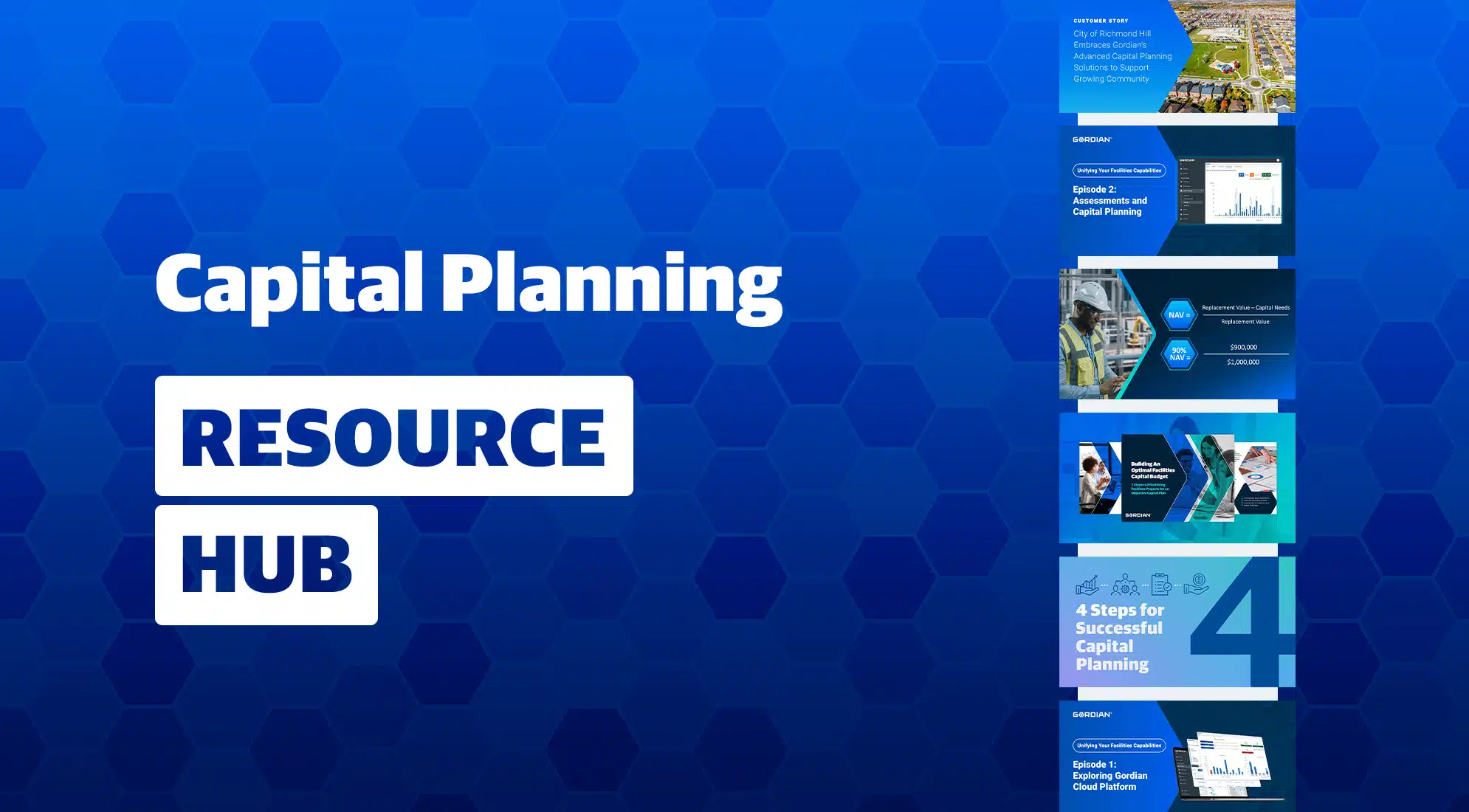
Utility Infrastructure Grades from the 2025 ASCE Report Card
June 30, 2025
Key Points:
- What is Utility Infrastructure and Why It Matters?
Utility infrastructure includes essential systems like water, sewer, gas, electrical, and steam lines that support facility operations. These systems are often underground and aging, making them difficult to monitor and maintain. Failure to address them proactively can lead to costly disruptions, safety hazards, and regulatory non-compliance. - Challenges in Managing Utility Infrastructure
Facilities teams often lack accurate documentation, real-time condition data, and dedicated funding for utility systems. These challenges make it hard to prioritize repairs or justify investments. The blog emphasizes the need for asset-level data and condition assessments to support informed decision-making and long-term planning. - Solutions for Proactive Utility Management
Gordian recommends using Facility Condition Assessments (FCAs) and GIS mapping tools to locate, evaluate, and plan for utility infrastructure needs. By integrating these tools with capital planning strategies, facilities teams can reduce risk, extend asset life, and ensure uninterrupted service delivery.
2025 ASCE Report Card: Utility Infrastructure
Published every four years by the American Society of Civil Engineers (ASCE), the Report Card for America’s Infrastructure assigns letter grades to over a dozen categories of U.S. infrastructure, from aviation to wastewater. The ASCE released its latest report card in March of 2025, along with new analysis and suggestions for improving infrastructure assets and, by extension, communities.
We grouped the grades into related categories to recap the ASCE’s most recent findings, compare grades with the previous report card, and add our own insights and analysis. In this post, we look at various utilities.
Infrastructure Sector 1: Electric Energy
2025 Grade: D+
2021 Grade: C-
ASCE’s 2025 Report Card for America’s Infrastructure indicates that the demand for energy is at a two-decade high. This spike is attributed to an influx of data centers, the operation of which requires the energy to power approximately 80,000 homes, higher demand for electric vehicles and the proliferation of Artificial Intelligence. No surprise, the spike in demand led to a spike in spending.
The 2025 Report Card revealed that utilities spending on transmission infrastructure jumped from $20 billion in 2022 to north of $27 billion 2023. Distribution spending hiked as well, from $44.5 billion in 2022 to almost $51 billion the following year as utilities sought to modernize equipment, replace old assets and install new lines and transformers. Energy providers had help footing the bill in the form of $73 billion in funding from the Infrastructure Investment and Jobs Act (IIJA). Unfortunately, $73 billion is a drop in the bucket, as the ASCE projects a $578 billion investment gap to expand capacity and meet increasing demand.
Download this free eBook to learn how strategic planning and innovative construction procurement can help you minimize the costs of emergency construction.
Infrastructure Sector 2: Dams
2025 Grade: D+
2021 Grade: D
America is home to more than 92,000 dams. These infrastructure assets are crucial for generating electricity, supplying drinking water and protecting communities from floods. Nearly 17,000 of those dams, or approximately 18%, are deemed to have high-hazard potential, meaning it is likely that failure will result in the loss of human life and widespread destruction of property. Age is a major determinant of hazard potential, and with 70% of dams at or over 50 years of age, improvements are necessary.
To that end, the IIJA provided approximately $3 billion to bolster dam safety, though it should be noted that Congress redirected $364 million of that funding for other purposes. Additionally, the IIJA gave $800 million to a pair of state programs tasked with monitoring, staffing and improving dams.
The ASCE reports that climate change is a significant factor contributing to the condition of America’s dams. Heavier and more frequent rainstorms and other weather events take a toll. With the intensity and incidence of extreme precipitation likely to continue increasing, states and other government entities must be prepared with emergency action plans.
See all of Gordian’s solutions for providing your community with reliable public utilities.
Infrastructure Sector 3: Broadband
2025 Grade: C+
2021 Grade: N/A
ASCE’s 2021 Report Card for America’s Infrastructure analyzed the state of the country’s broadband infrastructure without assigning a grade. They did, however, offer some startling statistics, like the National Association of Counties’ estimate that 65% of U.S. counties were saddled with internet connection speeds too slow to qualify as broadband.
The ASCE’s first-ever grade for U.S. broadband reflects that while the technology has been widely adopted nationwide (80% of adults have broadband access at home), there are still 24 million Americans lacking fixed broadband, including 28% of those in rural areas and more than 23% living on tribal lands.
The Broadband Equity Access and Deployment (BEAD) program, a U.S. Chamber of Commerce initiative aimed at expanding broadband access nationwide by 2030, estimates that reaching its goal will cost $61 billion. This is an achievable goal, especially considering federal investments in this technology are projected to reach over $42 billion over the same period, leaving the private sector to fund the remainder.
Again, the ASCE issues a warning about climate change. Natural disasters can disable and disrupt broadband service. Looking ahead, this infrastructure must be built with resilience in mind, which may look any number of ways. The Infrastructure Report Card cites backup batteries and other power sources, reinforcing cell towers and other solutions for combating climate change.
Recommendations for Improving Utility Infrastructure
Optimizing the operation of these assets will have tremendous benefits for communities everywhere. Here’s what the ASCE suggests to make utility infrastructure as powerful and efficient as possible.
Widespread standardization. Developing and enforcing standards for safety and resilience will go a long way toward making these services available to all.
Increased funding. Capital investment is necessary for enhancing the electric grid’s reliability, rehabilitating the nation’s dams and expanding broadband availability. This may be an area of opportunity for public-private partnerships.
Effective assessments. Mitigating risks and developing accurate long-term costs requires frequent asset inspections, particularly when it comes to the electric grid. ASCE also recommends that government agencies regularly meet reporting deadlines to ensure policymakers and other leaders have adequate data for making funding decisions.
Gordian can help with a variety of condition assessments for collecting facility and infrastructure data and the Gordian Cloud Platform, a revolutionary experience that delivers critical capabilities and connectivity across the building lifecycle. Organizations can store, update and synthesize their facilities data all in one place, giving them the power to make informed investment decisions quickly.
Gordian can also help complete identified utility infrastructure projects with Job Order Contracting (JOC). A streamlined construction procurement solution, JOC empowers organizations to complete many projects using one competitively awarded contract, significantly reducing the time to construction. Prices and proposal versions are available and recorded in the Gordian Cloud Platform, so leaders can defend every spending decision.
In every corner of the U.S., utility infrastructure is vital to modern life. Stronger assets mean better education, more economic opportunity and safer communities.
Share this:






